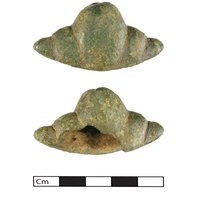
Viking Objects
Sword Pommel (NARC-E7AAF4)
An Anglo-Scandinavian copper-alloy sword pommel classed as a Petersen L type VI. The design is a fusion of Anglo-Scandinavian and Anglo-Saxon fashions. In many cases the design of the sword pommel is the only method of identifying the possible type and date of the sword it was attached to.
Read More
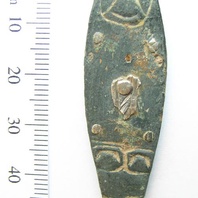
Viking Objects
Zoomorphic Strap-End (SWYOR-B89D43)
This Thomas Type A strap-end is decorated with zoomorphic designs and what seems to be a face which may fall into the Trewhiddle style. There is some trace evidence of silver plating. Strap-ends came in various styles and were fairly common throughout the Viking world. They were used to decorate the ends of belts and to stop them getting damaged.
Read More
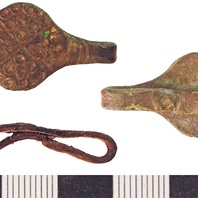
Viking Objects
Imitation Finger Ring (NLM-D675CA)
This finger ring bears stamped decoration imitating the Scandinavian ring and dot pattern which is bordered by incised crossing diagonals of a saltire. The ring- and dot-style of decoration was briefly adopted by inhabitants of Anglo-Saxon settlements such as Cottam in Yorkshire and Flixborough in Lincolnshire.
Read More
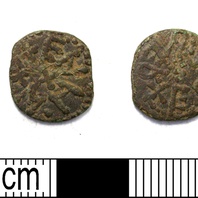
Viking Objects
Northumbrian Styca (LEIC-0D9D6F)
This Northumbrian styca was probably minted in the name of Æthelred II of Northumbria possibly by the moneyer Eanwulf. While Wessex and Mercia were using silver coinage as part of their monetary economy, Northumbria was using copper coins known as stycas, which may have contained trace amounts of silver. The concentration of these coins at sites such as Torksey and ARSNY (‘a riverine site near York’) suggests that they could have remained in circulation after the fall of Northumbria in 866 but were taken to these sites by the Vikings during their campaigning. This particular example was likely brought to Nottinghamshire from Northumbria by means of the Great Army’s overwintering activities in and around Nottingham.
Read More
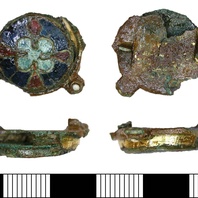
Viking Objects
Enamel Copper-Alloy Brooch (DENO-6C0D22)
This composite cast copper-alloy and enamel gilded brooch displays both Anglo-Scandinavian and Anglo-Saxon characteristics. The decorative enamel centre of the brooch was fabricated using a method known as cloisonné which involves the use of inlaid enamel cells, separated by strips of copper alloy, within an outer ring of copper alloy, all set upon a flat circular disc of copper alloy. The sides of the decorative roundel are surrounded with an upright strip of gilded copper alloy. The design of the enamel centre features a blue-green central quatrefoil, four cells which are shaped like elongated teardrops filled with red enamel giving the appearance of a cross motif, and four larger sub-rectangular cells filled with deep blue enamel. The brooch has been classified as Weetch Type 20. For more information on Scandinavian jewellery in England check out our blog: Brooches, Pendants and Pins: Scandinavian Dress Accessories in England.
Read More
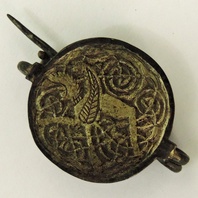
Viking Objects
Silver Gilt Brooch (1989-58/7224)
A circular silver gilt plate brooch with chip carved decoration of a winged creature. The creature may be a griffin. It is enmeshed in fine spiralling interlace. The reverse features a U-shaped catchplate and pin with a spring. This decoration is Mercian in style. For more information on Scandinavian jewellery in England check out our blog: Brooches, Pendants and Pins: Scandinavian Dress Accessories in England.
Read More
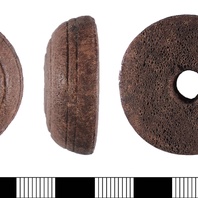
Viking Objects
Bone Spindle Whorl (LIN-9D24C2)
Fibres were spun into thread using a drop-spindle of which the whorls were made of bone, ceramic, lead, or stone and acted as flywheels during spinning. Other bone and ceramic spindle whorls with decorative circumference grooves are known from Anglo-Saxon sites elsewhere in areas such as West Stow, Suffolk.
Read More
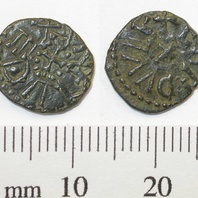
Viking Objects
Northumbrian Styca (DENO-87CE96)
This copper-alloy styca was minted by the moneyer Eardwulf in the name of King Ethelred II of Northumbria during his second reign. While Wessex and Mercia were using silver coinage as part of their monetary economy, Northumbria was using copper coins known as stycas, which may have contained trace amounts of silver. The concentration of these coins at sites such as Torksey and ARSNY suggests that they could have remained in circulation after the fall of Northumbria in 866 but were taken to the sites by the Vikings during their campaigning. they were not much use to the Vikings within their silver-based bullion economy but it is suggested that they were treated as raw material and were used as commodity money instead. The evidence for the production of copper-alloy strap-ends at Torksey and ARSNY supports this idea that the stycas were used for production.
Read More
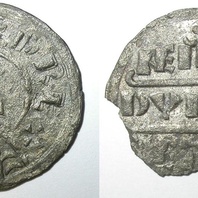
Viking Objects
Coin of Alfred the Great (1989-58/3381)
This silver penny from the mass grave at Repton was minted by a moneyer called Dudwine in Canterbury for Alfred the Great. Alfred was King of Wessex from 871 to 899 and spent most of his reign fighting off Viking invasions. He won a decisive victory at the Battle of Edington in 878 which resulted in a peace with the Vikings and the creation of the Danelaw. Minting coins was a way of controlling the means of exchange within a kingdom and which created a more easily administered standardized system of trade. Moreover, the coins themselves were often used as propaganda, portaying symbols and statements that gave off a desired message. The Vikings later used the minting of coins to legitimize their own rule.
Read More
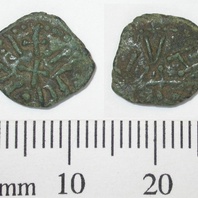
Viking Objects
Northumbrian Styca (DENO-EF4544)
The blundered legends on this example suggest it is an imitation of stycas minted for a Northumbrian ruler or the Archbishops of York. While Wessex and Mercia were using silver coinage as part of their monetary economy, Northumbria was using copper coins known as stycas, which may have contained trace amounts of silver. The concentration of these coins at sites such as Torksey and ARSNY suggests that they could have remained in circulation after the fall of Northumbria in 866 but were taken to the sites by the Vikings during their campaigning. They were not much use to the Vikings within their silver-based bullion economy but it is suggested that they were treated as raw material and were used as commodity money instead. The evidence for the production of copper-alloy strap-ends at Torksey and ARSNY supports this idea that the stycas were used for production.
